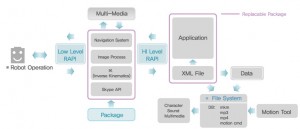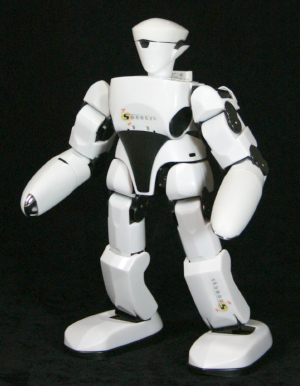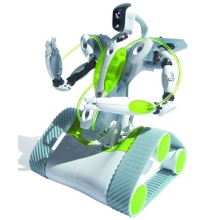The South Korean company Roboware has a monumental hit on their hands with their robot E3–for Emotional, Entertaining, and Eductional. The combination of a good technology architecture and a sound business model is what will make this robot a winner among personal and field consumer robots.
In an interview on Engineering TV, Roboware CEO Mike Kim recognizes the value of content as well as mobility capabilities. “Most companies focus on the movement of thier robots,” explains Kim. “Roboware will focus on both movement and content for E3.” The company’s strategy to is make the platform open source and allow application developers to use common technologies such as C# or Flash to control the robot.
The robot’s architecture is very conducive to application-level development. There is a low-level “RAPI” (Robot API) for scientists and researchers and a high-level RAPI for application developers. Researchers have access to an entire suite of technologies; a camera, microphones, sonar, touch sensors, 17 body joints, omni-directional platform, and many more goodies.
Application developers don’t have to worry about any of that stuff because they can use the high-level RAPI to interact with the user via a touch screen, microphone, and a motion tool provided by Roboware.
Among the most powerful technologies on board is the wifi connection to the internet. It opens the door for the now quasi-cliche telepresence applications as well as downloadable behaviors, software updates, or simply content acquisition. “Would you like to buy Dog Feeding Version 2.3?”
Kim explained that the robot would be available by Q2 for “under $3,000 USD.” That’s an obvious sticking point to mass-adoption of the platform but I’m very optimistic that these guys have got their stuff together enough to evolve the technology down to something more affordable. E3 reminds me a little of a robot we wrote about in ’07 named SPC-101C by Speecys. The robot costs about the same as E3 and we touted its programmability and WiFi capabilities.
SPC-101C is in the same class as E3 in both price and programmability but Speecys as a company is ahead of the pricing curve. According my friend Norri Kageki at GetRobo, Speecys is now making smaller version of SPC-101C called NNR-1 which will start selling around the same time as E3 but cost between $570 – $760 USD.
Nevertheless, against SPC-101C, E3 is clearly the dominant robot with regards to features, mobility, and system completeness. Additionally, E3’s omni-directional platform has mobility, stability, and practicality over bi-pedal humanoid robots. An annoying factor in bi-pedal personal robots is how slow they are in moving around. E3 appears very zippy and doesn’t have any trouble keeping up.
The NNR-1 will bring Speecys into the same pricing ballpark as some other robot platforms we’ve covered.
Spykee is still being positioned as a toy and although the manual says that its API is open source, nobody can seem to find it. In spite of such obstacles there are those who are brave enough to crack something open to make it work. Check out the iPhone-controlled Spykee project at Mr. Blog.
Mecanno has an opportunity with Spykee that is slowly fading. They were the first on the market with their “toy” but quickly thereafter iRobot came out with their telepresence robot ConnectR and WowWee came out with Rovio. All three fall into a comparable class but Spykee appears least mature. With the coming Speecys ‘bot, the market is getting more crowded.
There is something that all these personal robot companies lack–except for Roboware. It is the vision that the robot is a platform that should be open and easy to build and sell content for. This vision is what lifts Roboware above the others and is what compels me to believe that they will be the market leaders in the personal robotics space.
—
See the interview with Roboware CEO Mike Kim via Engineering TV:
—
Sources:
Related:





